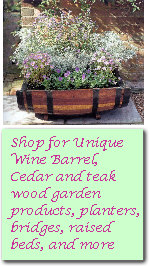Fungal diseases can mar the foliage and bracts of Virginia's
state flower, the native flowering dogwood, Cornus florida. The diseases,
spot anthracnose and Septoria leaf spot, appear every year to some degree and in
most years cause little damage. Discula anthracnose, on the other hand, can
eventually kill a tree. Another relatively recently observed disease of dogwood,
powdery mildew, can also be very destructive to the overall health of the tree.
This publication attempts to distinguish the symptoms of these four major
diseases of dogwood.
Spot Anthracnose
|
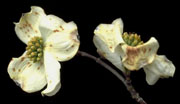
Fig. 1. Symptoms of spot anthracnose on bracts of flowering dogwood.
(Photo by M. A. Hansen)
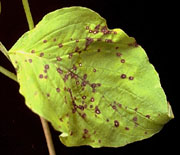
Fig. 2. Symptoms of spot anthracnose on leaves of flowering dogwood.
(Photo by M. A. Hansen) |
Symptoms
Symptoms of spot anthracnose, caused by the fungus Elsinoe
corni, first appear very early in the spring on the bracts, and later on the
foliage. In general, white cultivars of dogwood are more susceptible than pink
cultivars. The fungus causes uniformly tiny (less than 1/8" diameter), circular
lesions with purple borders and lighter, almost white, centers on bracts and
leaves (Figs. 1 and 2). These lesions are easily distinguished from leaf spots
caused by other dogwood pathogens because of their small and uniform size. Later
in the season, the centers of the spots often fall out, giving the leaf a
shotholed appearance. In seasons when environmental conditions are conducive to
disease, spots on bracts and foliage may be numerous, and leaves or bracts
become puckered or distorted around the spots as the leaves expand. Spots
similar to the leaf spots may also form on green branches and fruit; however,
the fungus does not cause dieback. In cases of severe infection, buds may fail
to open.
Disease Cycle
Elsinoe corni survives the winter
on twigs, in buds, or on infected fruit and leaves that remain on the tree. New
infections occur in early spring. In most years, spot anthracnose causes little
damage; however, in very cool, wet springs, symptoms can be severe.
Control
In most years control is not necessary; however, if disease
was severe the previous year or if a cool, wet spring is predicted, fungicides
may be warranted. Spot anthracnose can be controlled preventatively with
chlorothalonil (e.g. Daconil 2787), mancozeb (e.g. Fore or Dithane T/O), or
thiophanate methyl + mancozeb (e.g. Zyban). Spraying should begin when buds
begin to open and be repeated when bracts have fallen, four weeks after bract
fall, and in late summer after flower buds have formed.
Discula Anthracnose
|
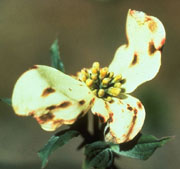
Fig. 3. Symptoms of Discula anthracnose on bracts of flowering dogwood.
(Photo by C. Hoysa)
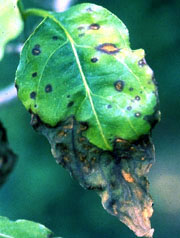
Fig. 4. Symptoms of Discula anthracnose on leaves of flowering dogwood.
(Photo by C. Hoysa) |
Symptoms
Discula destructiva, the fungus
that causes Discula anthracnose, not only causes leaf and bract symptoms on
dogwood, but also branch dieback that can culminate in death of the tree. Foliar
and bract symptoms include irregularly shaped, dark brown spots that vary from
pinpoint-sized to 1/4 inch or more in diameter (Figs. 3 and 4). Margins of spots
are purplish in color. Spots often coalesce and blight large portions of the
leaf, and affected leaves cling to the tree over the winter. The fungus moves
from the petioles into small twigs and then larger branches, causing dieback.
Lower branches usually die first, and in the final stages of disease, only a few
green branches may be left at the top of the tree (Fig. 5). Infection may
proceed to the trunk where cankers can cause death of the tree (Fig. 6). The
fungus can also invade the trunk directly through succulent water sprouts (young
shoots that form directly on the trunk). Water sprouts are very susceptible to
infection by the fungus.
Cycle
The fungus overwinters in stem cankers and leaves. It
sporulates profusely on infected tissues during the spring and summer. Spores
are spread by splashing rain. Prolonged, cool, wet weather in the spring or the
occurrence of fogs favors disease. The disease is more severe at high
elevations, perhaps because cool, wet conditions are more frequent in these
areas. The disease is much less frequent in the lower elevations of the eastern
part of Virginia where temperatures are generally higher.
Control
Because Discula destructiva causes cankers, this
disease is difficult to control. A combination of cultural and chemical methods
is recommended for most effective control. Once cankering is severe on a tree,
the tree can not be saved.
Cultural Control
Avoid planting dogwoods in sites where leaves will remain wet
for long periods of time. Sites along streams, lakes, or ponds, or areas where
fog tends to collect are prime sites for disease development and should be
avoided. The disease is more of a problem in shaded locations; thus, planting in
sunny locations can help to prevent disease. Although dogwood is naturally an
understory tree, trees that are properly cared for can do well in full sun.
Trees should be mulched to a depth of 2-4 inches to help
conserve soil moisture. Place mulch in a donut-shaped ring around the tree
instead of piling it against the base of the trunk. Placing mulch in contact
with the trunk causes bark to remain moist and become more susceptible to decay.
Water trees during drought and fertilize as needed to help trees remain
vigorous. Avoid using fertilizers high in nitrogen, however, as they can
stimulate succulent growth that is more susceptible to infection by Discula.
Water trees with a soaker hose rather than a sprinkler to avoid prolonged leaf
wetness.
Remove cankered branches and destroy them as soon as they are
noticed. Make cuts well below cankers through healthy wood. Sterilize pruning
tools between cuts with rubbing alcohol or a 10% solution of household bleach.
Remove any plant debris that falls to the ground from infected trees. Also,
avoid collecting and planting seed from wild dogwoods or transplanting dogwood
seedlings from the woods because these plant materials may harbor the fungus.
Chemical Control
Fungicides recommended for control of Discula anthracnose
include propiconazole (e.g. Banner) and chlorothalonil (e.g. Daconil 2787).
Propiconazole is a systemic fungicide that can be applied at 14-day intervals,
whereas chlorothalonil is a foliar protectant that should be applied every 7-10
days. Fungicide applications should begin before or as soon as bract spots
appear in the spring and continue throughout the season. It is important to
begin treatment before or during bract or foliar infection but before the fungus
invades the twigs. Once cankers have formed, fungicide treatment may not be
effective.
Resistance
Few cultivars of flowering dogwood have resistance to Discula
anthracnose. Breeding programs to identify sources of resistance are ongoing.
The 'Spring Grove' and 'Cherokee Sunset' cultivars of flowering dogwood have
been reported to have resistance to Discula anthracnose; however, 'Cherokee
Sunset' is very susceptible to powdery mildew. Chinese dogwood (Cornus kousa),
also called Kousa dogwood, although not immune, has resistance to Discula
anthracnose. Many cultivars of Kousa dogwood have high levels of resistance to
Discula anthracnose (Table 1). Other cultivars with lower levels of resistance
may develop leaf spots but do not develop cankers. Kousa cultivars with high
levels of resistance are the best choice for mixed plantings of Kousa and
flowering dogwood. If cultivars with less resistance are planted, they could
develop leaf spots and serve as a source of fungal inoculum for nearby flowering
dogwoods. Contact your nursery owner for the latest information on dogwoods with
resistance to Discula anthracnose.
|
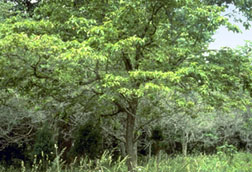
Fig. 5. Lower branch dieback due to Discula anthracnose.
(Photo by C. Hoysa) |
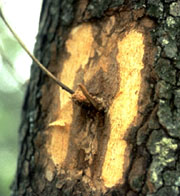
Fig. 6. Trunk canker caused by Discula destructiva.
(Photo by C. Hoysa) |
Septoria Leaf Spot
|

Fig. 7. Leaf symptoms of Septoria leaf spot.
(Photo by M. A. Hansen) |
Symptoms
Septoria leaf spot, caused by the fungus Septoria cornicola,
is a late-season disease of dogwood that is little cause for concern. Angular,
dark brown leaf spots with purplish margins, bordered by leaf veins, are typical
of this disease (Fig. 7). Leaf spots first appear in early July in Virginia, but
leaf spotting does not become severe until later in the summer. Symptoms caused
by Septoria could be confused with those of Discula anthracnose; however,
Septoria leaf spots are much more uniform in size (up to about 1/4 inch in
diameter) and angular. Also, Septoria does not cause a general blighting
of the leaf.
Disease Cycle
Septoria cornicola sporulates in
tiny, pinpoint-sized fruiting bodies in the leaf spots. Spores are spread by
wind and rain. The fungus overwinters in leaf debris.
Control
Because the most severe symptoms of Septoria leaf spot occur
late in the season when leaves are beginning to senesce naturally, no control is
recommended. Removing fallen leaves may help reduce the amount of fungal
inoculum available for infection the following season.
Powdery Mildew
Powdery mildews comprise a group of related fungal species
within the same family. Powdery mildew fungi are common on a wide variety of
ornamental species. Symptoms and signs of powdery mildews on different plant
species resemble one another; however, most species of powdery mildew fungi
infect only one or a few closely related species of host plants. Although
powdery mildews are common on other plants, the disease was not common on
dogwood in Virginia until 1993. It is possible that the species that is now
prevalent on dogwoods (Microsphaeria pulchra) was introduced just prior
to that time.
|
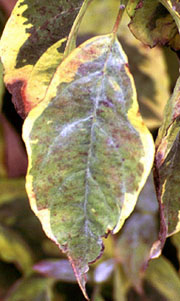
Fig. 8. Powdery mildew on leaves of flowering dogwood.
(Photo by R. E. Lyons, N.C. State Univ.) |
Symptoms
Mycelium of the powdery mildew fungus grows on leaf and bud
surfaces, and appears as a white coating on these plant parts (Fig. 8). In the
early stages of infection, the white fungal growth may be subtle and difficult
to see; however, symptoms of infection can be severe. Leaves may be stunted,
reddened, and curled or puckered by mid-season. Affected trees appear
water-stressed even if adequate water has been provided. The disease has been
shown to cause stunting of roots and, after repeated years of infection, the
tree may be stunted overall. Both flowering and Kousa dogwood are susceptible to
this disease, although resistant cultivars of both species have been identified.
Disease Cycle
The fungus survives as mycelium in infected buds and on leaves
on the ground. Spores form in spring and are spread by air currents to newly
developing leaves. Like other powdery mildew fungi, the dogwood pathogen is
favored by warm days, cool nights, and high humidity. Frequent rainfall actually
inhibits spore germination.
Control
Chemical Control
Several fungicides are available for control of powdery mildew
on dogwood. These include triadimefon (e.g. Bayleton), myclobutanil (e.g.
Systhane), trifloxystrobin (e.g. Compass), potassium bicarbonate (e.g. Remedy,
First Step, Armicarb 100), and Neem oil extract (e.g. Triact 70). Triadimefon
and myclobutanil act systemically; trifloxystrobin penetrates the leaf surface;
potassium bicarbonate and Neem oil extract act at the leaf surface. Refer to the
current Virginia Pest Management Guide for Home Grounds and Animals (VCE
Publication 456-018) or the Virginia Pest Management Guide for Horticultural and
Forest Crops (VCE Publication 456-017), http://www.ext.vt.edu/pubs/pmg/,
for details on rates and timing of fungicide application for this and other
diseases of dogwood. For information on the proper use of pesticides and
fungicides, refer to any current VCE pest management guide.
Resistance
Resistant cultivars of both flowering and Kousa dogwood are
available. Because this disease has become so prevalent in recent years,
resistant cultivars are a wise choice for new plantings. Refer to, Powdery
Mildew-Resistant Woody Ornamentals (VCE
Publication 450-616W) for a list of dogwood cultivars resistant to powdery
mildew.
|
Table 1.
Dogwood cultivars with resistance to Discula anthracnose
(data from N. C. State University, 1996) |
|
Cultivar |
Resistance |

|
|
Big Apple |
Good |
|
China Girl |
Good |
|
Elizabeth Lustgarten |
Good |
|
Gay Head |
Good |
|
Greensleeves |
Good |
|
Julian |
Good |
|
Milky Way |
Good |
|
Milky Way Select |
Excellent |
|
Steeple |
Excellent |
|
Temple Jewel |
Good |
|
Aurora** |
Good |
|
Celestial** |
Excellent |
|
Constellation** |
Good |
|
Ruth Ellen** |
Good |
|
Stardust** |
Excellent |
|
Stellar Pink** |
Excellent |
|
**Cornus florida x C. kousa hybrid.
|
Author: Mary Ann Hansen, Extension Plant Pathologist,
Department of Plant Pathology, Physiology and Weed Science, Virginia Tech
![]() Gardeners' Corner
Kids'
Garden
Sustainable Garden
Contact Us
Gardeners' Corner
Kids'
Garden
Sustainable Garden
Contact Us![]()

